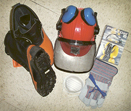Training Room 3: Keeping Safe and Healthy—Methods for Controlling Potential Hazards
Session 2: Ergonomic Health and Safety Practices
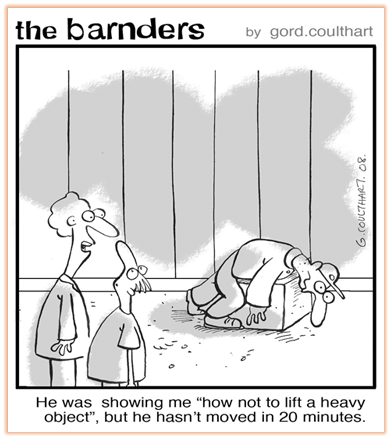
Gordon Coulthart/Courtesy of Canadian Agricultural Safety Association
Farm work involves physical movement, often while managing heavy loads. This includes lifting, carrying, loading, shovelling, bending, pushing and pulling. Farmers also experience long periods of time sitting or standing on machines such as tractors that have strong vibrations, or walking on hard and uneven surfaces in the barn and farmyard. All of these activities can lead to repetitive strain injuries and other musculoskeletal injuries.
Ergonomics
"Ergonomics is the scientific study of people at work. The goal of ergonomics is to reduce stress and eliminate injuries and disorders associated with the overuse of muscles, bad posture, and repeated tasks. This is accomplished by designing tasks, work spaces, controls, displays, tools, lighting, and equipment to fit the employee´s physical capabilities and limitations."
From US Centers for Disease Control and Prevention
This means that farm workers need to be aware of safe and healthy techniques for moving, lifting and carrying, ensuring that they care for their bodies during work. Having adequate rest and taking breaks from repetitive work, wearing appropriate footwear and clothing, learning the proper techniques for equipment use and taking time to use effective stretching and body care can all help to reduce musculoskeletal strain. Good ergonomic work habits will help to control hazards and reduce injury.
Learning Target
In this session you will describe and demonstrate your understanding of the use of ergonomic practices for movement and use of proper tools to protect against a variety of hazards when moving and working with equipment on the farm. As you work through the session, keep the following questions in mind:
- How are workers trained to reduce stress and injury while using tools, equipment and their bodies in your agricultural setting?
- What are the most significant ergonomic practices promoted in your workplace?
Lifting, Carrying, Pushing, and Pulling
Lifting, carrying, pushing, and pulling are all part of the work of farming. If this work is done without proper ergonomic techniques, pain and injury can occur.
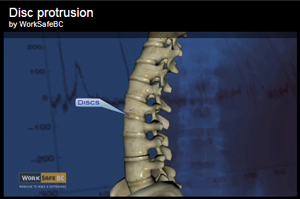
© 2005 Workers Compensation Board of British Columbia.
All rights reserved.
Watch Disc Protrusion from WorkSafeBC to learn more about your back and possible disc protusion injury caused by improper moving of heavy objects.
Ten Steps to Safe Handling of Heavy Objects
-
Size up the load and check conditions. Don’t try to lift it alone if the load looks too heavy or awkward. Ensure there is enough space for movement, the footing is good and no obstacles are in your path. This preparation will help prevent you from tripping or stumbling.
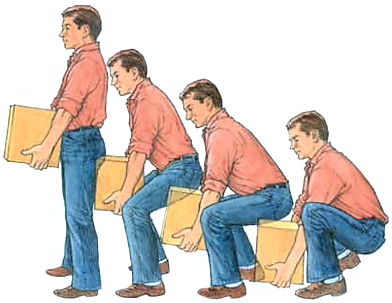
© 2005 Workers Compensation Board of British Columbia. All rights reserved.
Safe lifting technique.
- Be sure your balance is good. Feet should be shoulder-width apart, with one foot beside and the other foot behind the object being lifted.
- Bend the knees; don’t stoop. Keep the back straight, but not vertical. (Tucking in your chin will straighten your back.)
- Grip the load with the palms of your hands and your fingers. The palm grip is much more secure. Tuck your chin again to ensure your back is straight before you lift.
- Use your body weight to start moving the load. Allow the lifting action to come from the big, strong muscles in your legs, rather than the weaker muscles in your back.
- Keep your arms and elbows close to your body while lifting.
- Carry the load close to your body. Don’t twist your body while carrying the load. To change direction, shift your foot position and turn your whole body.
- Watch where you are going!
- To lower the object, bend the knees. Don’t stoop. Set the load down. If you are placing it on a bench or shelf, set it on the edge and then push it back into position. Make sure your hands and feet are clear when placing the load.
- Make it a habit to follow this procedure when lifting anything, even a relatively light object.
Alberta Farm Safety. Used with permission.
Websites and Interactivities
To Do
Think about the kind of lifting you do on your worksite. Try two of the activities below to help you consider how you will move and work safely to prevent injury.
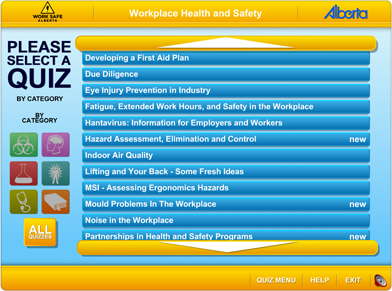
© Alberta Employment and Immigration.¬†Used with permission.
Work Safe Alberta has made a series of Work Place Fun Quizzes. Choose from the quizzes that are connected to ergonomics and health and safety on the worksite (Lifting and Your Back, Fatigue and Extended Work Hours, Working Alone Safely).
You may have to enlarge the interactive to 200% or more to see it clearly.
Work Safe Alberta has made this interactive elearning activity, Backs and Bums: Applying Basic Ergonomics, to help you learn more about safe lifting and carrying techniques.
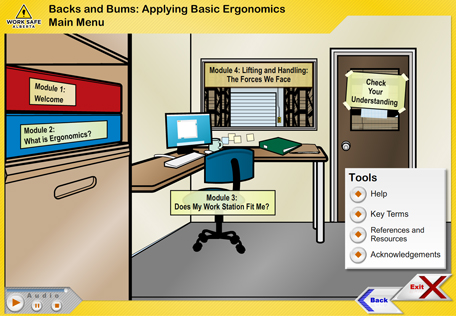
© Alberta Employment and Immigration.¬†Used with permission.
If the link doesn't work, try cutting and pasting this URL into your address bar: http://employment.alberta.ca/whs/learning/ergonomics/data/ergonomics.html
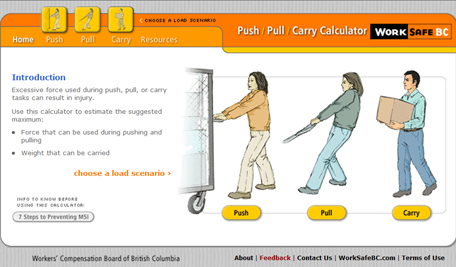
© 2005 Workers Compensation Board of British Columbia.¬†All rights reserved.
WorkSafeBC has developed a Push, Pull, Lift Calculator that suggests the maximum weight of loads depending on different scenarios. Think about your workplace and the kinds of things you do. Use this interactive tool to find out if you are working safely.
Working Alone
Some tasks are designed to be performed alone (such as driving a tractor), but other tasks are much safer when completed with help. Working alone does have an upside. It can be peaceful and productive – no one looking over your shoulder, no one to distract you from the task at hand. On the other hand, it can also result in tragedy – such as injury, health impairment or victimization.
To ensure your safety on the farm, you and your employer need to work together to plan safety measures to be used when working alone. Once your employer provides the plan and the tools to carry it out, the next step is for you to take responsibility for your own safety. Know the job. Know the hazard. Know the drill.
Adapted from Alberta Farm Safety.  Used with permission
Read
Farm workers are not covered by Alberta's Occupational Health and Safety Code for working alone. Each farm must develop its own standards and procedures to ensure safety for workers who are working alone. Create a personal action plan you should follow to keep yourself safe when working alone, or describe the standards and policies for working alone on your worksite.
Read the article from Alberta Agriculture and Rural Development to find out more about how to work alone safely: Safety Up—On Working Alone
Ergonomic Practices in Your Workplace
Checking In
Your Task: Sharing Your Understanding of Ergonomic Practices for Health and Safety on Your Worksite
To Do—Communicate with Co-workers
-
Promote a particular ergonomic practice that will protect workers on your worksite from injury. Choose an ergonomic hazard present on your worksite and describe the ergonomic practices workers can use to reduce their risk.
-
Find a website that describes a technique or the proper use of a tool so that you have evidence to promote safe practices and controls for the hazard. What do you think is the most important thing to communicate to co-workers about working with ergonomic safety factors to control this hazard?
- Develop a way to communicate a safety message about your concern to your co-workers. You should describe the hazard you are concerned about and the ergonomic safety practice that will protect the workers on your site. Support your claim with a reference to an appropriate website you have chosen that provides evidence for your ideas.
You could
Submit your work as arranged with your teacher.
- send an email to a co-worker or supervisor and "cc" your teacher
- develop a Hazard Assessment Checklist that could be used on your worksite
- create a safety awareness campaign that could be used to build public awareness of your concern (you might choose to create an infomercial, a poster or a bumper sticker)
- analyze and revamp, if necessary your worksite's safety protocol for your hazard
- choose a communication tool of your own that you've agreed on with your teacher
Courtesy of Claude LeBlanc and The Canadian Agricultural Safety AssociationIf you want to demonstrate your understanding of ergonomic practices in your Health and Safety Action Plan, you can use the communication tool you created above to help describe part of your plan to protect workers on your worksite. Add it to your collection of materials for your Health and Safety Action Plan.
